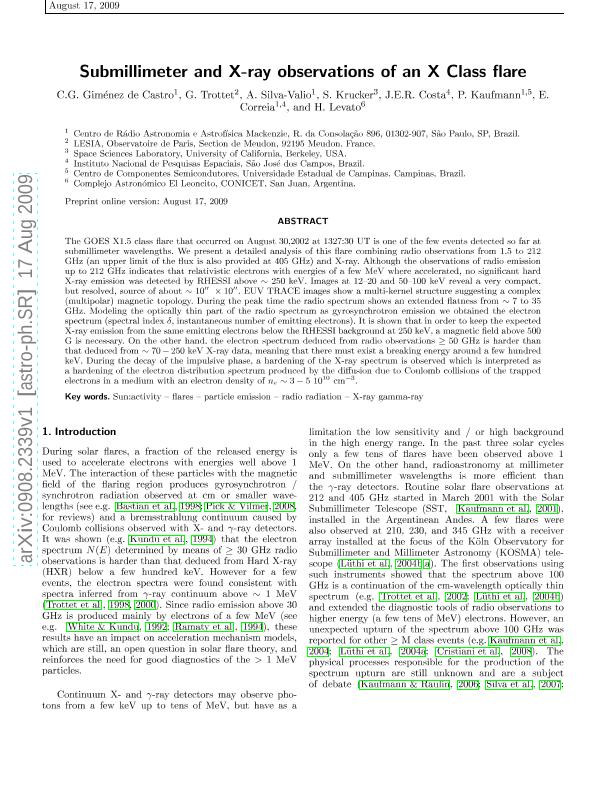Mostrar el registro sencillo del ítem
dc.contributor.author
Gimenez de Castro, Carlos Guillermo
dc.contributor.author
Trottet, G.
dc.contributor.author
Silva Valio, Adriana
dc.contributor.author
Krucker, Sam
dc.contributor.author
Costa, Joaquim
dc.contributor.author
Kaufmann, Pierre

dc.contributor.author
Correia, Emilia

dc.contributor.author
Levato, Orlando Hugo

dc.date.available
2022-10-04T02:42:59Z
dc.date.issued
2009-11
dc.identifier.citation
Gimenez de Castro, Carlos Guillermo; Trottet, G.; Silva Valio, Adriana; Krucker, Sam; Costa, Joaquim; et al.; Submillimeter and X-ray observations of an X class flare; EDP Sciences; Astronomy and Astrophysics; 507; 1; 11-2009; 433-439
dc.identifier.issn
0004-6361
dc.identifier.uri
http://hdl.handle.net/11336/171583
dc.description.abstract
The GOES X1.5 class flare that occurred on August 30, 2002 at 1327:30 UT is one of the few events detected so far at submillimeter wavelengths. We present a detailed analysis of this flare combining radio observations from 1.5 to 212 GHz (an upper limit of the flux is also provided at 405 GHz) and X-ray. Although the observations of radio emission up to 212 GHz indicates that relativistic electrons with energies of a few MeV were accelerated, no significant hard X-ray emission was detected by RHESSI above ∼250 keV. Images at 12-20 and 50-100 keV reveal a very compact, but resolved, source of about ∼10" ×10". EUV TRACE images show a multi-kernel structure suggesting a complex (multipolar) magnetic topology. During the peak time the radio spectrum shows an extended flatness from ∼7 to 35 GHz. Modeling the optically thin part of the radio spectrum as gyrosynchrotron emission we obtained the electron spectrum (spectral index d, instantaneous number of emitting electrons). It is shown that in order to keep the expected X-ray emission from the same emitting electrons below the RHESSI background at 250 keV, a magnetic field above 500 G is necessary. On the other hand, the electron spectrum deduced from radio observations =50 GHz is harder than that deduced from 70-250 keV X-ray data, meaning that there must exist a breaking energy around a few hundred keV. During the decay of the impulsive phase, a hardening of the X-ray spectrum is observed which is interpreted as a hardening of the electron distribution spectrum produced by the diffusion due to Coulomb collisions of the trapped electrons in a medium with an electron density of ne ∼ 3-5 × 1010 cm-3. © 2009 ESO.
dc.format
application/pdf
dc.language.iso
eng
dc.publisher
EDP Sciences

dc.rights
info:eu-repo/semantics/openAccess
dc.rights.uri
https://creativecommons.org/licenses/by-nc-sa/2.5/ar/
dc.subject
SUN: ACTIVITY
dc.subject
FLARES
dc.subject
PARTICLE EMISSION
dc.subject
RADIO RADIATION
dc.subject.classification
Astronomía

dc.subject.classification
Ciencias Físicas

dc.subject.classification
CIENCIAS NATURALES Y EXACTAS

dc.title
Submillimeter and X-ray observations of an X class flare
dc.type
info:eu-repo/semantics/article
dc.type
info:ar-repo/semantics/artículo
dc.type
info:eu-repo/semantics/publishedVersion
dc.date.updated
2020-05-11T19:22:15Z
dc.journal.volume
507
dc.journal.number
1
dc.journal.pagination
433-439
dc.journal.pais
Francia

dc.description.fil
Fil: Gimenez de Castro, Carlos Guillermo. Universidad Presbiteriana Mackenzie. Centro de Radiotronomia y Astrofisica; Brasil
dc.description.fil
Fil: Trottet, G.. Observatorio de Paris; Francia
dc.description.fil
Fil: Silva Valio, Adriana. Universidad Presbiteriana Mackenzie. Centro de Radiotronomia y Astrofisica; Brasil
dc.description.fil
Fil: Krucker, Sam. University of California; Estados Unidos
dc.description.fil
Fil: Costa, Joaquim. Instituto Nacional de Pesquisas Espaciais; Brasil
dc.description.fil
Fil: Kaufmann, Pierre. Universidade Estadual de Campinas; Brasil
dc.description.fil
Fil: Correia, Emilia. Universidad Presbiteriana Mackenzie; Brasil
dc.description.fil
Fil: Levato, Orlando Hugo. Consejo Nacional de Investigaciones Científicas y Técnicas. Centro Científico Tecnológico Conicet - San Juan. Instituto de Ciencias Astronómicas, de la Tierra y del Espacio. Universidad Nacional de San Juan. Instituto de Ciencias Astronómicas, de la Tierra y del Espacio; Argentina
dc.journal.title
Astronomy and Astrophysics

dc.relation.alternativeid
info:eu-repo/semantics/altIdentifier/doi/http://dx.doi.org/10.1051/0004-6361/200912028
dc.relation.alternativeid
info:eu-repo/semantics/altIdentifier/url/https://www.aanda.org/articles/aa/full_html/2009/43/aa12028-09/aa12028-09.html
dc.relation.alternativeid
info:eu-repo/semantics/altIdentifier/url/https://arxiv.org/abs/0908.2339v1
Archivos asociados
